2011 HONDA ODYSSEY service
[x] Cancel search: servicePage 547 of 722
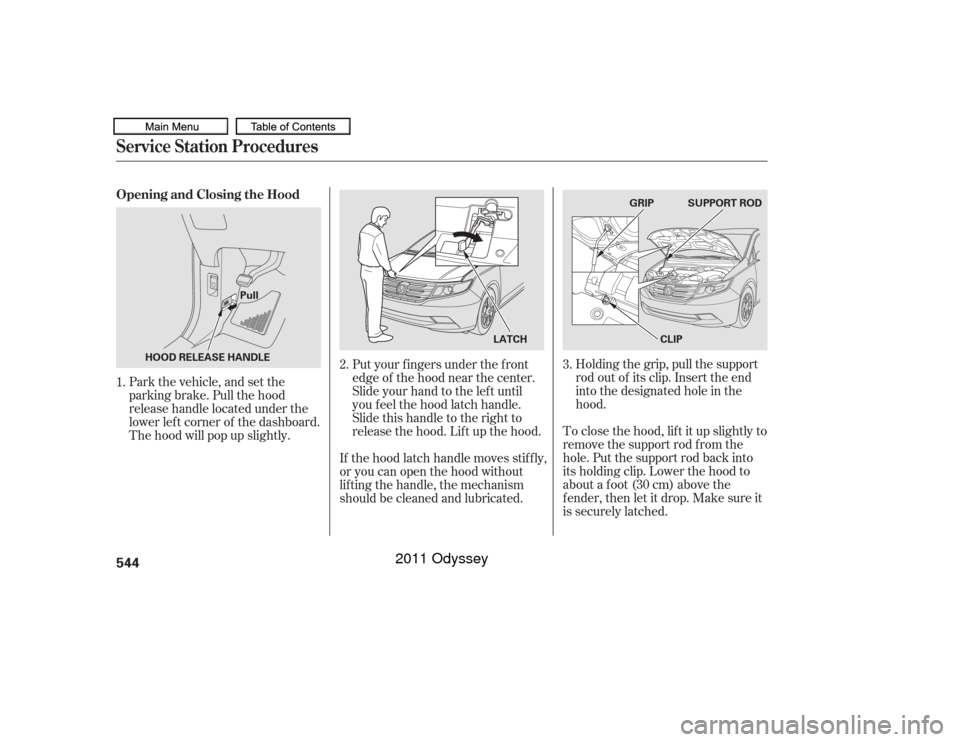
Holding the grip, pull the support
rod out of its clip. Insert the end
into the designated hole in the
hood.
To close the hood, lif t it up slightly to
remove the support rod f rom the
hole. Put the support rod back into
its holding clip. Lower the hood to
about a f oot (30 cm) above the
f ender, then let it drop. Make sure it
is securely latched.
Put your f ingers under the f ront
edge of the hood near the center.
Slide your hand to the lef t until
you f eel the hood latch handle.
Slide this handle to the right to
release the hood. Lif t up the hood.
If the hood latch handle moves stif f ly,
or you can open the hood without
lif ting the handle, the mechanism
should be cleaned and lubricated.
Park the vehicle, and set the
parking brake. Pull the hood
release handle located under the
lower lef t corner of the dashboard.
The hood will pop up slightly.
1.
3.
2.
Service Station ProceduresOpening and Closing the Hood544
SUPPORT ROD
LATCH CLIP
GRIP
Pull
HOOD RELEASE HANDLE
10/07/17 10:47:36 31TK8600_549
2011 Odyssey
Page 548 of 722
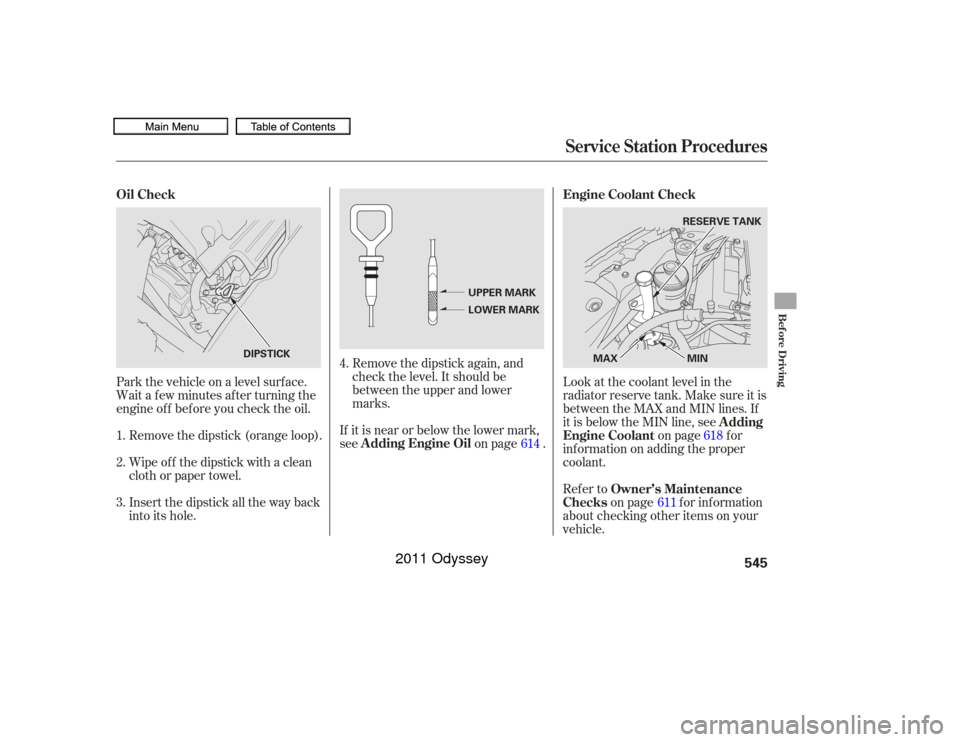
Refer toon page f or inf ormation
about checking other items on your
vehicle. Look at the coolant level in the
radiator reserve tank. Make sure it is
between the MAX and MIN lines. If
it is below the MIN line, see on page f or
inf ormation on adding the proper
coolant.
Remove the dipstick again, and
check the level. It should be
between the upper and lower
marks.
If it is near or below the lower mark,
see on page .
Park the vehicle on a level surf ace.
Wait a f ew minutes af ter turning the
engine of f bef ore you check the oil.
Remove the dipstick (orange loop).
Wipe of f the dipstick with a clean
cloth or paper towel.
Insert the dipstick all the way back
into its hole. 4.
618
614
1.
2.
3.
611Service Station Procedures
Owner’s Maintenance
Checks A dding
Engine Coolant Engine Coolant Check
A dding Engine Oil
Oil Check
Bef ore Driving
545
UPPER MARK
LOWER MARK
MIN
MAX RESERVE TANK
DIPSTICK
10/07/17 10:47:47 31TK8600_550
2011 Odyssey
Page 575 of 722

When the low tire pressure indicator
is on, one or more of your tires is
signif icantly underinf lated. You
should stop and check your tires as
soon as possible, and inf late them to
the proper pressure as indicated on
the vehicle’s tire inf ormation placard.
If you think you can saf ely drive a
short distance to a service station,
proceed slowly, and inf late the tire to
the recommended pressure shown
on the driver’s doorjamb.
If the tire is f lat, or if the tire
pressure is too low to continue
driving, replace the tire with the
compact spare tire (see page ).
If you cannot make the low tire
pressure indicator go out af ter
inflating the tires to the specified
values, have your dealer check the
system as soon as possible.Driving on a signif icantly under
inf lated tire causes the tire to
overheat and can lead to tire failure.
Underinf lation also reduces f uel
efficiency and tire tread life, and may
af f ect the vehicle’s handling and
stopping ability.
Becausetirepressurevariesby
temperature and other conditions,
the low tire pressure indicator may
come on unexpectedly.
Each tire has its own pressure
sensor (not including the spare tire).
If the air pressure of a tire becomes
signif icantly low while driving, the
sensor in that tire immediately sends
a signal that causes the low tire
pressure indicator to come on. Your vehicle is equipped with a tire
pressure monitoring system (TPMS)
that turns on every time you start the
engine and monitors the pressure in
your tires while driving.
655
Except Touring models
Low Tire Pressure
Indicator
Tire Pressure Monitoring System (TPMS)572
10/07/17 10:51:23 31TK8600_577
2011 Odyssey
Page 577 of 722

If you have a f lat tire, the low tire
pressure indicator will come on.
Replace the flat tire with the
compact spare tire (see page ).
Each wheel (except the compact
sparetirewheel)isequippedwitha
tire pressure sensor. You must use
TPMS specif ic wheels. It is
recommended that you always have
your tires serviced by your dealer or
qualif ied technician.The low tire pressure indicator or
the TPMS indicator will go off, after
several miles (kilometers) driving,
when you replace the spare tire with
the specif ied regular tire equipped
with the tire pressure monitor sensor.
Never use a puncture-repairing agent
in a f lat tire. If used, you will have to
replace the tire pressure sensor.
Havetheflattirerepairedbyyour
dealer as soon as possible.
After you replace the flat tire with
thecompactsparetire,thelowtire
pressure indicator stays on. This is
normal; the system is not monitoring
the spare tire pressure. Manually
check the spare tire pressure to be
sure it is correct. Af ter several miles
(kilometers) driving with the
compact spare tire, the TPMS
indicator comes on and the low tire
pressure indicator goes of f . Your vehicle is equipped with a tire
pressure monitoring system (TPMS)
that turns on every time you start the
engine and monitors the pressure in
your tires while driving.
Each tire has its own pressure
sensor (not including the spare tire).
If the air pressure of a tire becomes
signif icantly low while driving, the
sensor in that tire immediately sends
a signal that causes the low tire
pressure/TPMS indicator to come
on.
655
On Touring models
Changing a T ire with T PMSTire Pressure Monitoring System (TPMS)574
10/07/17 10:51:38 31TK8600_579
2011 Odyssey
Page 579 of 722
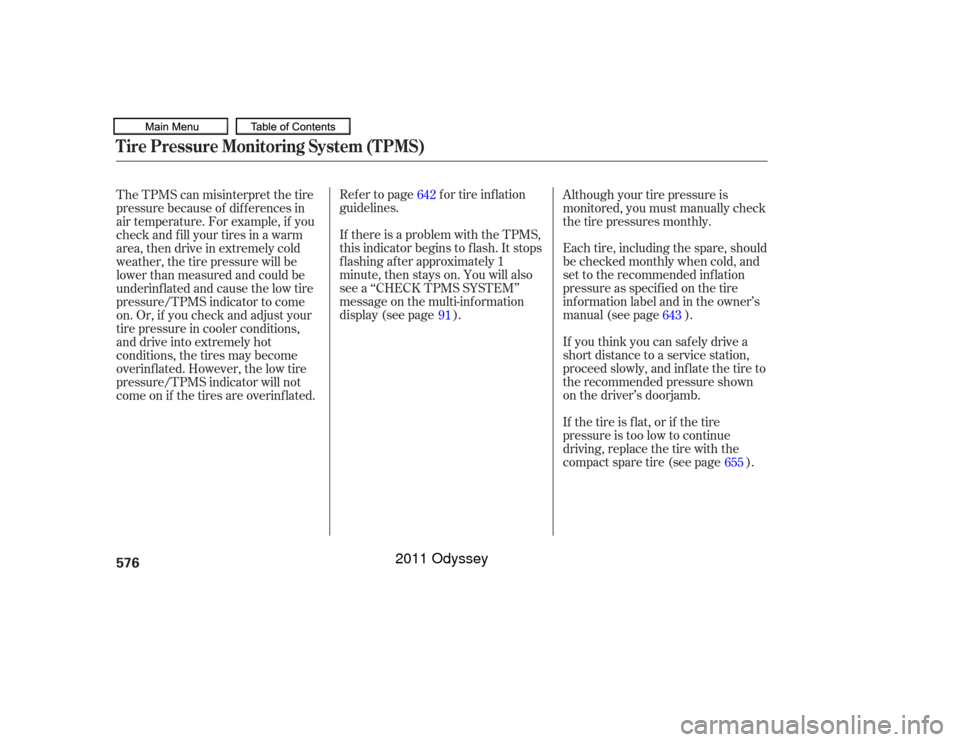
Refer to page for tire inflation
guidelines.
If there is a problem with the TPMS,
this indicator begins to f lash. It stops
flashing after approximately 1
minute, then stays on. You will also
see a ‘‘CHECK TPMS SYSTEM’’
message on the multi-inf ormation
display (see page ).Although your tire pressure is
monitored, you must manually check
thetirepressuresmonthly.
Each tire, including the spare, should
be checked monthly when cold, and
set to the recommended inf lation
pressure as specif ied on the tire
information label and in the owner’s
manual (see page ).
If you think you can saf ely drive a
short distance to a service station,
proceed slowly, and inf late the tire to
the recommended pressure shown
on the driver’s doorjamb.
If the tire is f lat, or if the tire
pressure is too low to continue
driving, replace the tire with the
compact spare tire (see page ).
The TPMS can misinterpret the tire
pressure because of dif f erences in
air temperature. For example, if you
check and f ill your tires in a warm
area, then drive in extremely cold
weather, the tire pressure will be
lowerthanmeasuredandcouldbe
underinf lated and cause the low tire
pressure/TPMS indicator to come
on.Or,if youcheckandadjustyour
tire pressure in cooler conditions,
and drive into extremely hot
conditions, the tires may become
overinf lated. However, the low tire
pressure/TPMS indicator will not
come on if the tires are overinf lated.
91
642
643
655
Tire Pressure Monitoring System (TPMS)576
10/07/17 10:51:51 31TK8600_581
2011 Odyssey
Page 581 of 722

This indicator and the warning
message on the multi-inf ormation
display will go of f , af ter several miles
(kilometers) driving, when the spare
tire is replaced with the specified
regular tire equipped with the tire
pressure monitor sensor.
Each wheel is equipped with a tire
pressure sensor mounted inside the
tire behind the valve stem. You must
use TPMS specif ic wheels. It is
recommended that you always have
your tires serviced by your dealer or
a qualif ied technician.
Never use a puncture-repairing agent
in a f lat tire. If used, you will have to
replace the tire pressure sensor.
Havetheflattirerepairedbyyour
dealer as soon as possible.If the low tire pressure/TPMS
indicator and the low tire position on
the low tire pressure monitor do not
go out af ter inf lating the tires to the
specified values, have your dealer
check the system as soon as possible.
As required by the FCC:
This device complies with Part 15 of theFCC rules. Operation is subject to thef ollowing two conditions: (1) This devicemay not cause harmf ul interf erence, and(2) this device must accept anyinterf erence received, includinginterf erence that may cause undesiredoperation.
Changes or modif ications not expresslyapproved by the party responsible f orcompliance could void the user’sauthority to operate the equipment.
This device complies with IndustryCanada Standard RSS-210.Operation is subject to the f ollowing twoconditions: (1) this device may not causeinterf erence, and (2) this device mustaccept any interf erence that may causeundesired operation of the device.
Tire Pressure Monitoring System (TPMS)578
10/07/17 10:52:06 31TK8600_583
2011 Odyssey
Page 597 of 722
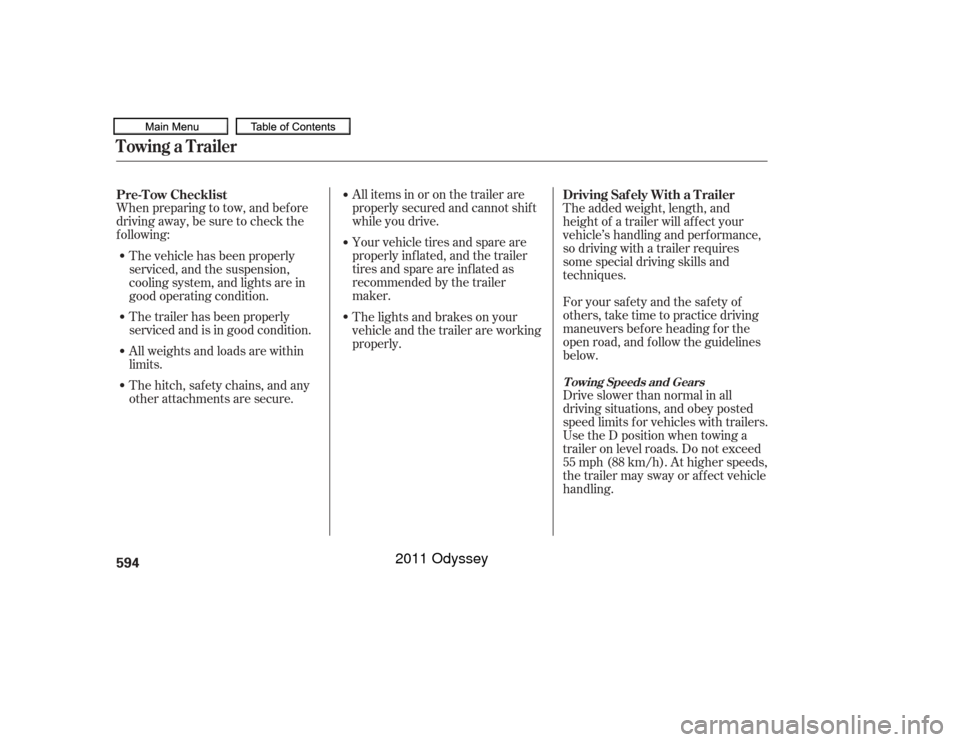
When preparing to tow, and bef ore
driving away, be sure to check the
f ollowing:All items in or on the trailer are
properly secured and cannot shif t
while you drive.
Your vehicle tires and spare are
properly inf lated, and the trailer
tires and spare are inflated as
recommended by the trailer
maker.The added weight, length, and
height of a trailer will af f ect your
vehicle’s handling and perf ormance,
so driving with a trailer requires
some special driving skills and
techniques.
Foryoursafetyandthesafetyof
others,taketimetopracticedriving
maneuvers bef ore heading f or the
open road, and f ollow the guidelines
below.
Drive slower than normal in all
driving situations, and obey posted
speed limits f or vehicles with trailers.
Use the D position when towing a
trailer on level roads. Do not exceed
55 mph (88 km/h). At higher speeds,
the trailer may sway or affect vehicle
handling.
The vehicle has been properly
serviced, and the suspension,
cooling system, and lights are in
good operating condition.
The trailer has been properly
serviced and is in good condition.
All weights and loads are within
limits.
Thehitch,safetychains,andany
other attachments are secure.
The lights and brakes on your
vehicle and the trailer are working
properly.
Pre-T ow Checklist
Driving Saf ely With a T railer
T owing Speeds and Gears
Towing a Trailer594
10/07/17 10:54:00 31TK8600_599
2011 Odyssey
Page 600 of 722
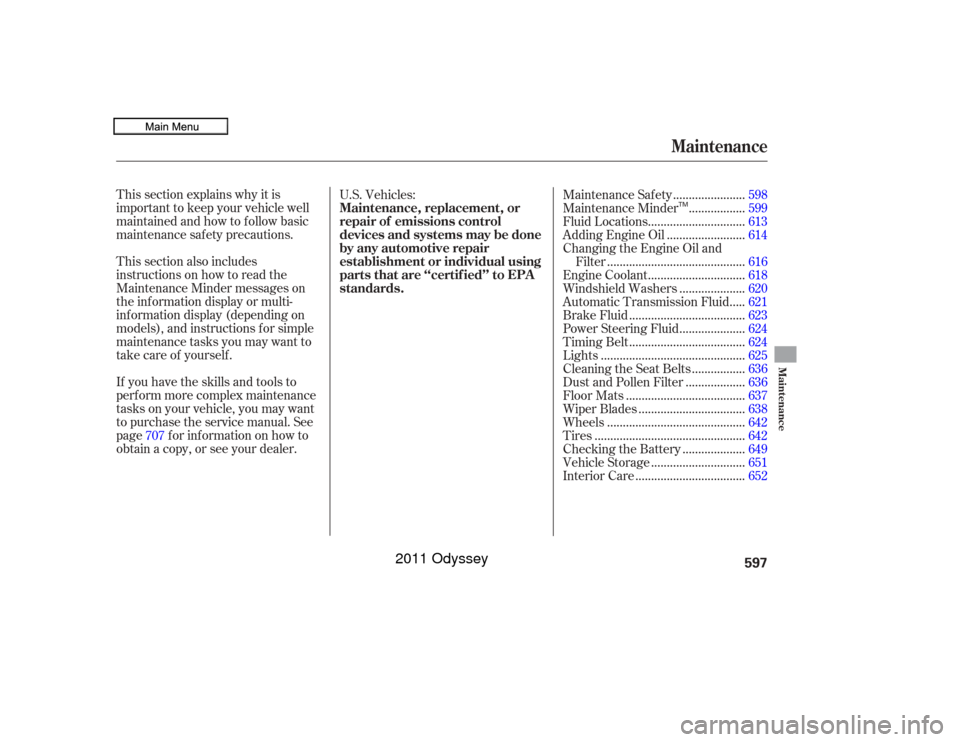
This section explains why it is
important to keep your vehicle well
maintained and how to f ollow basic
maintenance saf ety precautions.
If you have the skills and tools to
perf orm more complex maintenance
tasks on your vehicle, you may want
to purchase the service manual. See
page f or inf ormation on how to
obtain a copy, or see your dealer.U.S. Vehicles:
This section also includes
instructions on how to read the
Maintenance Minder messages on
the inf ormation display or multi-
inf ormation display (depending on
models), and instructions f or simple
maintenance tasks you may want to
take care of yourself . ......................
Maintenance Saf ety .598
.................
Maintenance Minder . 599
..............................
Fluid Locations .613
........................
Adding Engine Oil .614
Changing the Engine Oil and ...........................................
Filter .616
..............................
Engine Coolant .618
....................
Windshield Washers .620
....
Automatic Transmission Fluid . 621
....................................
Brake Fluid .623
....................
Power Steering Fluid . 624
....................................
Timing Belt .624
.............................................
Lights .625
................
Cleaning the Seat Belts . 636
..................
Dust and Pollen Filter . 636
.....................................
Floor Mats .637
.................................
Wiper Blades .638
...........................................
Wheels .642
...............................................
Tires .642
...................
Checking the Battery . 649
.............................
Vehicle Storage .651
..................................
Interior Care .652
707
Maintenance
Maintenance, replacement, or
repair of emissions control
devices and systems may be done
by any automotive repair
establishment or individual using
parts that are ‘‘certif ied’’ to EPA
standards.
Maint enance
597
TM
10/07/17 10:54:18 31TK8600_602
2011 Odyssey